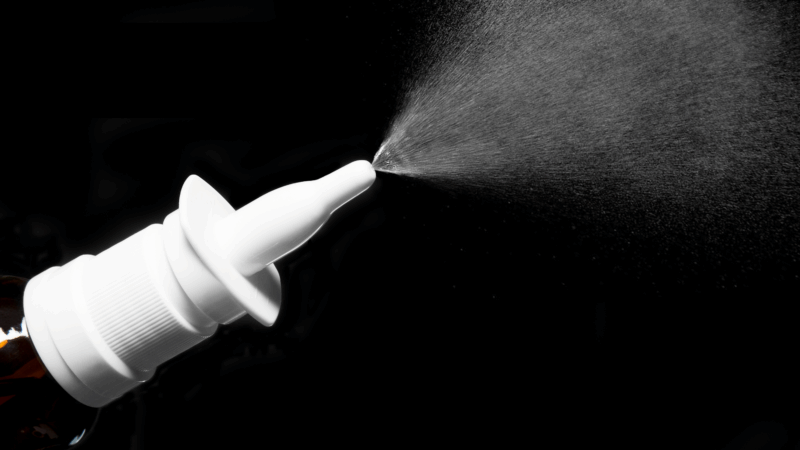Here’s how to use nasal spray right and more tips for managing spring allergies
If you feel like your seasonal allergies are getting worse every year, it’s not just you. Warming from climate change is making the pollen season longer, and more people are going to the doctor each year looking for relief, according to a recent research review published in the journal The Laryngoscope.
One study the reviewers looked at found the pollen season had already gotten 20 days longer in North America between 1990 and 2018, and several studies found an increase in average daily pollen concentrations.
Luckily, there are ways to keep the pollen from taking over your life. NPR asked doctors for tips to help you manage your spring allergies before they manage you.
This story comes from NPR’s Health newsletter. Want more stories on the science of healthy living? Subscribe here.
1. Keep the outside outside
Pollen can be carried in on just about any surface, warns Dr. Zachary Rubin a pediatric allergist and clinical immunologist who blogs about allergies and shares allergy-related tips on social media. Taking your shoes off and storing them in a closet or foyer is a good start, but there’s more.
When you come home, “before you sit down on furniture or in your bed, you ideally should take off any clothes that would have been touching the outside world,” Rubin says. Socks, pants, shirts all go directly in your laundry. Rubin also recommends taking a shower or a bath before bed to rinse pollen from your skin and hair.
When indoors, Rubin recommends keeping your windows and doors closed as much as possible. That may be a bummer if you love a spring breeze, but you’re inviting pollen and mold into your house whenever you open the windows, says Rubin.
If you’re allergic to pollen, the stuff is more likely to float through windows on a dry and windy day. Rubin says rainy days are good for flushing pollen out of the air. But if you’re allergic to mold, it’s better to keep windows shut on rainy days too.
If you’ve just got to open those windows, Rubin says an indoor air purifier can provide some relief.
2. Wipe down or bathe your pets
If you have a dog, cat or any pet who spends time outside, wipe the animal off whenever they come inside, says Rubin. You can pick up allergy-friendly wipes at pet stores. It’s also worth giving pets more frequent baths to remove pollen, says Dr. Neelima Tummala, an ENT physician and clinical assistant professor in otolaryngology at the New York University Grossman School of Medicine.
3. Keep your nose clean
First, look at when pollen counts are really high and try to avoid being outdoors during those times of day, advises Tummala. Right now we’re in tree pollen season … and tree pollen tends to be highest in the mornings, she says.
Want to enjoy nature with fewer sneezes? It turns out the masks we got used to wearing to prevent COVID transmission “can be very helpful actually,” says Rubin, when it comes to keeping out pollen and mold. He points to research where health care workers during the COVID-19 pandemic reported reduced allergy symptoms when they were wearing masks.
It’s also a good idea to rinse out your nose when you get home, says Rubin. You can do that with a neti pot or a saline spray. If you go the neti pot route, be sure to use distilled water, or tap water that’s been boiled and cooled down, Rubin cautions. (Water straight from the tap comes with a small risk of sending an amoeba to eat your brain – eek!)
3. Know your meds and when to use what
Different allergy medications treat different symptoms. Here are a few common ones, and what to know about how to use them.
- Oral and nasal antihistamines. If you’re experiencing itchy eyes, a runny nose, or sneezing, an oral antihistamine like Zyrtec, Claritin, or Allegra should help, Rubin says. Astepro is a nasal spray with antihistamine, which Rubin usually recommends pairing with a steroid spray.
- Steroid nasal sprays. If you’ve got congestion or postnasal drip, that’s where nasal sprays come in. Examples of common steroid sprays are Flonase, Nasacort and Nasonex. However, “We don’t always tell people to take [steroid sprays] year-round,” says Rubin. So check with your physician about how long you should be using it. Nasal steroid sprays take a few weeks to kick in, notes Tummala. With pollen season starting earlier, “you may need to start your intranasal steroid spray earlier than you used to,” so they’ll be optimally effective, she says.
- Nasal decongestants. If you’re really stuffed up and need instant relief, you may want to try a nasal decongestant spray like Afrin or Vicks Sinex, Rubin says. These sprays shrink the blood vessels in your nasal passages. But Rubin cautions against using them for more than 3 to 5 days at a time, because after you stop, you can develop a rebound nasal congestion that gets progressively worse. “You almost become dependent upon it and it’s hard to get rid of,” he warns.
4. Nasal spray the right way
You’re probably doing it wrong. I know I was. “A lot of people just naturally go, snort, spray, snort. What that does is it just shoots the medicine to the back of your throat where you taste it. And if you taste it, you waste it,” Rubin says.
He demonstrated how to use nasal spray properly in a TikTok that went viral. Here’s his secret to getting it right:
“I tell people ‘nose to toes.’ So you look down and then you place the nozzle up, but then you tilt it slightly towards the ear on the same side as your nostril. And after you spray on each side, you look forward and breathe through your mouth. Breathe normally, maybe a slight inhalation through your nose, but you never snort it,” Rubin advises.
Why aim towards the ear? The ear is connected to the back of the throat and nasal cavity through the eustachian tube, so decreasing inflammation in that area will lower the risk of getting fluid behind your ear. Pointing the spray bottle towards the ear also targets openings between your nasal passages and your sinuses, lowering your risk of developing a sinus infection, says Rubin.
5. Be aware of factors that can worsen your allergic reaction
Rubin uses a concept called the allergy symptom threshold to explain how exposure to multiple allergens, along with other factors, can trigger symptoms. ”You could be exposed to one pollen grain and not sneeze, but if you’re exposed to a thousand, you’re going to sneeze because there’s enough there that will activate the immune system,” he explains.
That goes for different kinds of allergens too. For instance, last week I was in Washington D.C., contending with pollen from the lovely cherry blossoms outside, and my sister’s cat Felicia indoors. My sinuses were not pleased.
“It’s like you have a cup and you’re filling it with different allergens and exposures, says Rubin.” (He illustrates the concept in another video.)
Other factors can also increase your likelihood of having an allergic reaction. For some people Rubin says, drinking alcohol lowers the threshold, and some are more vulnerable when they exercise, particularly outdoors.
If you happen to be sick, “your immune system is aggravated and hyperactive,” Rubin says, and more likely to respond to allergens. (It can also work the other way around – if mucus builds up in your sinuses because of allergies and you’re less able to fend off a respiratory infection that comes your way, he says.)
It goes back to reducing exposure, says Rubin: The more you can cut back your exposures to all kinds of allergens and irritants, the more successful you’ll be at preventing an allergic reaction.
NPR’s Maria Godoy contributed to this report.
U.S. military strikes 5 more alleged drug boats, killing 8
The U.S. military says it struck five alleged drug-smuggling boats over two days. The attacks killed eight people, while others jumped overboard and may have survived. U.S. Southern Command did not reveal where the attacks occurred.
Capitol riot ‘does not happen’ without Trump, Jack Smith told Congress
Former special counsel Jack Smith also described President Trump as the "most culpable and most responsible person" in the criminal conspiracy to overturn the 2020 election results, according to a transcript of Smith's closed-door interview with the House Judiciary Committee.
Trump will drop push for National Guard deployments in Chicago, LA and Portland, Ore.
Courts blocked troops from deploying in Chicago and Portland, Ore., and the Los Angeles deployment effectively ended after a judge blocked it earlier this month.
What Stranger Things gets right about wormholes
The final episode of fifth season of the Netflix series Stranger Things is out this week, and the concept of a wormhole figures largely into it. While the show is a work of fiction, theoretical wormholes have making appearances for decades not only in science fiction but in actual science.
Photos: The world welcomes the new year
As fireworks light the sky and crowds count down together, communities around the globe welcome 2026.
Meet five new species discovered in 2025
A bumpy snailfish, Andean mouse opossum and ancient sea cow were just some of the many species described in 2025.







